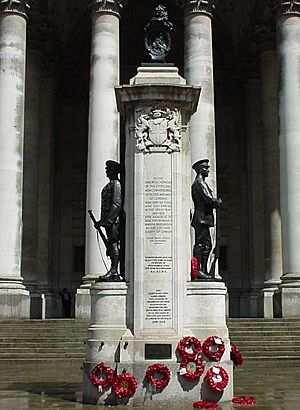London Troops War Memorial facts for kids
The London Troops War Memorial stands proudly in front of the Royal Exchange in the City of London. It remembers the brave men from London who fought in World War I (1914–1919) and World War II (1939–1945). This special monument helps us never forget their service and sacrifice.
Contents
What the Memorial Looks Like
The memorial is a tall column, about 7.5 meters (25 feet) high. It is made from Portland stone, a type of white limestone. The column sits on a strong granite base.
Around the column, there are bronze (a type of metal) statues. Two life-sized bronze soldiers stand on either side. One soldier represents the Royal Fusiliers, and the other represents the Royal Field Artillery. They are standing at ease, holding their rifles.
At the very top of the column is a bronze lion. This lion is standing on its back legs, holding a round medal. The medal shows Saint George and the Dragon, with the words "St George for England".
On the front (west side) of the column, you can see a carving of the coat of arms of the City of London. Below this, there are special messages dedicated to the soldiers.
On the back (east side), there is the coat of arms of the County of London. Below this, you'll find a list of all the London army groups that fought in the First and Second World Wars. These include famous groups like the Royal Fusiliers and the Honourable Artillery Company.
Many of these groups served in important army divisions. These divisions fought mainly on the Western Front in Europe. Some also fought in places like Salonika and Egypt. On the north and south sides of the column, there are carvings of three flags. Each flagpole has a crown and a wreath on top.
How the Memorial Was Built
The bronze statues on the memorial were created by a sculptor named Alfred Drury. These bronze parts were made at a place called the Albion Art Foundry. The stone carvings and letters were done by William Silver Frith.
The main architect, who designed the memorial, was Sir Aston Webb. He was a very important architect at the time. Sir Aston Webb first suggested a different design, but it was not chosen. His second design was accepted.
The money needed to build the memorial, which was £7,000, was collected from the public. People donated money to help create this important monument. To make space for the memorial, a drinking fountain had to be moved to a different street nearby.
When the Memorial Was Revealed
The London Troops War Memorial was officially revealed on a foggy day, 12 November 1920. A large crowd gathered for the event. This was just one day after the ceremony to bury the Unknown Warrior at Westminster Abbey.
Prince Arthur, Duke of Connaught and Strathearn was supposed to unveil the memorial. However, he was unable to attend. So, Prince Albert, Duke of York (who later became King George VI) unveiled it instead.
A special guard of honour and a military band were present from the 3rd Battalion Grenadier Guards. There was also a parade of soldiers from different London military groups.
For many years after the unveiling, clerks from the nearby Bank of England took care of the flowers left at the memorial. In 1923, smaller copper copies of the memorial were given to the London army groups listed on the monument.
The memorial was recognized as a special historic building in June 1972. It was given a higher protection status in June 2016. This was to mark 100 years since the Battle of the Somme, a very important battle in World War I.
What the Memorial Says
TO THE // IMMORTAL HONOUR // OF THE OFFICERS // NON-COMMISSIONED // OFFICERS AND MEN // OF LONDON // WHO SERVED THEIR // KING AND EMPIRE // IN THE GREAT WAR // 1914–1919 // THIS MEMORIAL IS // DEDICATED IN PROUD & // GRATEFUL RECOGNITION // BY THE CITY AND // COUNTY OF LONDON
THEIR NAME LIVETH FOR EVERMORE.
UNVEILED ON NOV 12TH 1920 BY // H.R.H. THE DUKE OF YORK // ON BEHALF OF // FIELD MARSHAL H.R.H. //THE DUKE OF CONNAUGHT // K.G., K.T., K.P.
AND // ALBEIT MANY UNITS // NAMED HEREON // HAVE CHANGED IN // DESIGNATION AND ROLE // WE HONOUR AND // REMEMBER THE MEN // AND WOMEN WHO SERVED // IN ALL THE UNITS OF // THE CITY AND COUNTY // OF LONDON IN THE WAR OF // 1939–1945.
There is also a brass plaque on the memorial. It says that the money for the memorial was raised by public donations. This happened in 1919, when Sir Horace Brooks Marshall was the Lord Mayor. This brass plaque was added after 1945. It replaced some original words that were removed when a new dedication for World War II was added.
More Pictures of the Memorial
-
Plaque referring to the mayoralty of Horace Brooks Marshall












